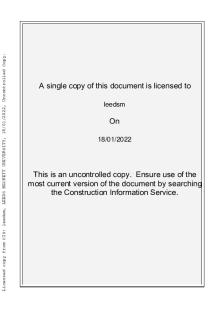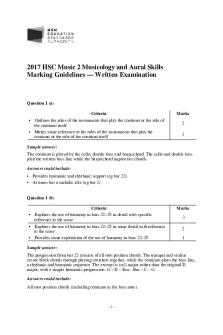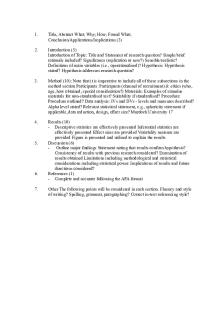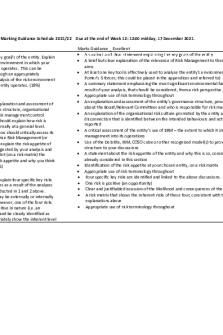Essay Marking Guide PDF

| Title | Essay Marking Guide |
|---|---|
| Course | Law |
| Institution | Cardiff University |
| Pages | 5 |
| File Size | 154.6 KB |
| File Type | |
| Total Downloads | 37 |
| Total Views | 154 |
Summary
marking criteria...
Description
Essay Marking Guide.
‘The legal definition of “land” is straightforward – it refers only to the surface layer of the earth.’ Critically discuss. This is a fairly broad question, which may well attract a variety of answer approaches. We always remember the limited word space available to students but also reward accurate creativity within answers.
It is hoped that students will focus on land rights above and below the surface and demonstrate good knowledge of the various corporeal and incorporeal rights that fall within the statutory definition of land. A good starting point would be to acknowledge the many facets/understandings of ‘land’ and thus it is necessary that the law must recognise/regulate rights that may arise at the surface (re topographical features – trees/buildings/walkways/bridges/walls etc… but also subjacent – minerals/wells/liquid deposits/support/water conduit/cables/drainage easements etc… and, of course, superjacent – waterways, airspace – domains. The focus should be on subjacent/superjacent rights. The Latin maxim ‘Cuius est solum eius est usque ad coelum et ad inferos’ will be cited, I suspect. Since the question opens with the ‘legal definition of land’ Students should: – Consider/mention the legal definition of ‘land', found in the LPA 1925 – s.205(1)(ix) – Give particular focus, where appropriate, to the terms corporeal / incorporeal hereditaments. This should be done accurately. – Provide examples of land rights that exist above and below the ground, to counter the claim that the legal definition of land is straightforward. Some distinction should be made between corporeal and incorporeal hereditaments. 1. Superjacent land rights Students’ should: - Demonstrate knowledge of how individuals/companies can commit actionable trespass by straying into another’s airspace thus linking the answer to the maxim, ‘cuius est solum’. - Demonstrate knowledge/understanding of the legal implications of the distinction between the lower and upper stratum of airspace. The lower stratum of airspace comprises the portion of the immediately superjacent airspace, the effective control of which is necessary for a person’s reasonable enjoyment of their land at ground level.
-
Discuss, or draw on, the Bernstein of Leigh v Skyviews 1978 case; particularly the objective test. A good student may critically examine recent changes to aviation legislation. Previously the Rules of the Air Regulations 2007, Sch 1, r 5(3)(b) stated that aircraft is not permitted to fly closer than 500 feet to any person, vessel, vehicle or structure. These have been replaced by the Standardised European Rules of the Air Regulation (EU) No 923/2012 (in force Dec 2014) rules 5005(f)(2) and 5015(b) states that except during take-off/landing, aircraft shall not be flown at heights of less than 1000 ft over congested areas/cities, or less than 500 ft otherwise.
2. Subjacent land rights Students’ should: - Consider various subjacent rights that might arise – for example, drainage easements, Internet cables and so on. - Trespass under land – so again they might refer to the maxim: cuius est solum, eius est usque ad coelum et ad inferos – which is of course subject to limitations. Students might refer to right to airspace; and, as regards subterranean ownership, some might again mention the Supreme Court case Star Energy Weald Basin Ltd v Bocardo SA [2010] UKSC 35, in this context. - Better answers might consider the application of this case to drilling below the ground – which when diagonal beneath land belonging to another, without permission, constituted an actionable trespass. - Very good / excellent answers would engage with the fact that Bocardo no longer applies to fracking (poorer answers may spend too long discussing Bocardo, which provides interesting background but is legally irrelevant). The Infrastructure Act 2015 s.43(1)-(2) now gives oil/gas companies an automatic right of underground access, making trespass irrelevant. This right only applies to ‘deep level’ land, defined in s. 43(4) as any land at a depth of at least 300 metres. As the drilling is taking place at 1000m below the surface, Ima has no claim in trespass. - Excellent answers might also note that there is an expectation (but no legal obligation) that gas operators would set up a community payment scheme (s. 45 – this states that, if payment schemes do not operate successfully on a voluntary basis, the Sec of State has powers to legislate for it.) Currently, the voluntary industry-led payment schemes propose to give communities hosting shale gas projects £100,000 per well ‘fracked’ during exploration plus 1% of future revenues. – 3. Good students may draw on extended reading and discuss rights to river water
-
-
Acknowledge that the right to abstract the river water is strictly controlled by the requirement that a licence is needed to do so (subterranean s.24(1)). However, a licence is not needed if the water is abstracted for the domestic purposes of the occupier’s household or for agricultural purposes (s.27(4)(b) Water Resources Act 1991). Discuss the landowner’s natural right to the ‘flow of water, and the enjoyment of it’ (Embrey v Owen 1851), provided that the owner does not deprive those lower down the stream of its flow. Recognise the general points of law here and cite the correct statutory provisions on this specific issue. Engage with any relevant commentary.
4. Fixtures and Chattels Students’ should – Distinguish between fixtures (treated as part of the land) and chattels (physical objects that never lose their independent character as mere ‘personalty’, even if placed in close relation to realty). – Refer to s 62(1) LPA 1925, which indicates that the statutory definition of ‘land’ includes ‘fixtures’ attached to the land. – Consider the annexation test: Holland v Hodgson (1872) LR 7 CP 328, Blackburn J – the test, depends on the circumstances of each case, but relates to:
i.
Physical degree or mode of annexation, - The more firmly, permanently or irreversibly an object is fixed to the earth or a building thereon, the more likely it is to be classified as a fixture. - If article in question is held there only by gravity, then it is likely to be chattel – see Blackburn J in Holland v Hodgson – when ‘the article in question is no further attached to the land than by its own weight it is generally considered to be a mere chattel’. - Examples: Spinning loom bolted to floor of mill = fixture – Holland v Hodgson Automatic car wash bolted to ground = fixture – Lombard and Ulster Banking v Kennedy [1974] Air conditioning equipment bolted onto or ducted into walls = fixture – Herbert v British Railways Board (1999)
Kitchen units carefully surrounded by tiling = indicates intention to annex units permanently to realty = fixture – but freestanding cooker = chattel – Botham v TSB Bank (1996) ii.
Purpose of annexation. -
-
-
-
Objective test. Subjective intentions of the fixer may have some persuasive value, but much greater importance attached to objective intention or underlying purpose of annexation as indicated by surrounding circumstances, duration of annexation, and shared understandings of function to be served by annexation. Is object integral to landscape/interior design? eg substantial garden ornaments, if the presence of those ornaments is integral to the permanent architectural design or part of general scheme for improvement of realty – Hamp v Bygrave (1983) – while a freestanding garden gnome in a suburban garden constitutes a chattel, a substantial collection of carefully coordinated garden ornaments may well comprise a group of fixtures. Or if tem is ‘so heavy that there is no need to tie it into a foundation’ (Berkley v Poulett [1977]), then it may be deemed to be fixture. Elitestone v Morris (1997) – bungalows. D’Eyncourt v Gregory (1866) – heavy marble statues of lions = fixtures. Conversely, items that are firmly fixed to realty may remain chattels if the purpose of their annexation is merely to facilitate their enjoyment as chattels, eg tapestries (Leigh v Taylor [1902]), display cabinets of stuffed birds (Viscount Hill v Bullock [1897]). So the fundamental question is: does the item improve the realty or enhance the chattel? The case law is not uniform or consistent, eg in Botham v TSB Bank – freestanding cooker constituted chattel, whereas in Palumberi v Palumberi (1986) a freestanding gas stove was deemed to be fixture because it was ‘an essential and integral element’ of kitchen.
Grade Boundary Guidance Solid answers (2.2) will identify some, perhaps not all, of the issues arising, but show some knowledge of the relevant cases and legal principles.
Good answers (2.1) will cite a range of relevant cases and statutory provisions. Good answers recognise the decline in significance of Bocardo and importance of the Infrastructure Act 2015. Excellent answers (1st class) will deal with most issues in depth, citing a range of relevant cases and addressing more subtle points like community payment schemes/aviation schemes etc....
Similar Free PDFs

Essay Marking Guide
- 5 Pages

Essay-Marking Workshop
- 1 Pages

Essay Marking Guidelines
- 1 Pages

UKCA Marking Marking of Steel
- 21 Pages

Marking rubric
- 1 Pages

2017 hsc marking guide music 2
- 6 Pages

Essay Guide
- 15 Pages

Coursework Marking Scheme
- 4 Pages

Bone marking worksheet
- 2 Pages

Food Diary Marking template
- 1 Pages
Popular Institutions
- Tinajero National High School - Annex
- Politeknik Caltex Riau
- Yokohama City University
- SGT University
- University of Al-Qadisiyah
- Divine Word College of Vigan
- Techniek College Rotterdam
- Universidade de Santiago
- Universiti Teknologi MARA Cawangan Johor Kampus Pasir Gudang
- Poltekkes Kemenkes Yogyakarta
- Baguio City National High School
- Colegio san marcos
- preparatoria uno
- Centro de Bachillerato Tecnológico Industrial y de Servicios No. 107
- Dalian Maritime University
- Quang Trung Secondary School
- Colegio Tecnológico en Informática
- Corporación Regional de Educación Superior
- Grupo CEDVA
- Dar Al Uloom University
- Centro de Estudios Preuniversitarios de la Universidad Nacional de Ingeniería
- 上智大学
- Aakash International School, Nuna Majara
- San Felipe Neri Catholic School
- Kang Chiao International School - New Taipei City
- Misamis Occidental National High School
- Institución Educativa Escuela Normal Juan Ladrilleros
- Kolehiyo ng Pantukan
- Batanes State College
- Instituto Continental
- Sekolah Menengah Kejuruan Kesehatan Kaltara (Tarakan)
- Colegio de La Inmaculada Concepcion - Cebu





